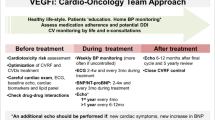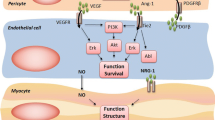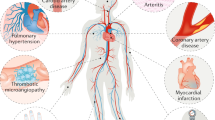Abstract
Purpose of Review
Numerous chemotherapeutic agents have been associated with the development of ischemia and arterial thrombosis. As newer therapies have been developed to treat cancer, some of these chemotherapy drugs have been implicated in the development of vascular disease. In this review, we will summarize the most common chemotherapeutic drug classes that may play a role in the development of ischemic heart disease.
Recent Findings
Angiogenesis inhibitors, alkylating agents, antimetabolites, antimicrotubules, and proteasome inhibitors have a number of cardiovascular toxicities. The possible mechanisms of action of these drugs leading to ischemic complications are varied but include endothelial dysfunction, platelet aggregation, reduced levels of nitrous oxide (NO), and elevated levels of reactive oxygen species (ROS), and vasospasm. While some drugs act through multiple pathways that result in the development of ischemic heart disease, others such as the antimetabolites and antimicrotubules appear to primarily cause vasospasm. Furthermore, while aromatase inhibitors increase the risk of heart disease in comparison to tamoxifen in large studies, this finding likely occurs because of a protective role of tamoxifen on cardiovascular risk factors rather than a direct effect of aromatase inhibitors.
Summary
Angiogenesis inhibitors, alkylating agents, antimetabolites, antimicrotubules, and proteasome inhibitors can lead to ischemic complications in patients with cancer. Many of these drugs have proven to be effective in improving cancer prognosis, but their possible cardiovascular effects have to be carefully monitored and treated. Treatment of ischemic complications in the setting of cancer therapy should focus on the optimal medical management of known cardiovascular risk factors and follow an evidence-based approach.


Similar content being viewed by others
References
Papers of particular interest, published recently, have been highlighted as: • Of importance
Fuster V, Voute J. MDGs: chronic diseases are not on the agenda. Lancet. 2005;366(9496):1512–4. https://doi.org/10.1016/S0140-6736(05)67610-6.
American Cancer Society. Cancer Facts & Figures 2015 Atlanta: American Cancer Society; 2015.
Cancer: Fact Sheet (Internet). World Health Organization 2017. Available from: http://www.who.int/mediacentre/factsheets/fs297/en/.
Yusuf SW, Razeghi P, Yeh ET. The diagnosis and management of cardiovascular disease in cancer patients. Curr Probl Cardiol. 2008;33(4):163–96. https://doi.org/10.1016/j.cpcardiol.2008.01.002.
Basavaraju SR, Jones TD. Atherosclerotic risks from chemicals: part I. Toxicological observations and mechanisms of atherosclerosis. Arch Environ Contam Toxicol. 1998;35(1):152–64. https://doi.org/10.1007/s002449900363.
Ross JS, Stagliano NE, Donovan MJ, Breitbart RE, Ginsburg GS. Atherosclerosis and cancer: common molecular pathways of disease development and progression. Ann N Y Acad Sci. 2001;947:271–92. discussion 92-3
Lestuzzi C, Viel E, Picano E, Meneguzzo N. Coronary vasospasm as a cause of effort-related myocardial ischemia during low-dose chronic continuous infusion of 5-fluorouracil. Am J Med. 2001;111(4):316–8. https://doi.org/10.1016/S0002-9343(01)00808-7.
Bathina JD, Yusuf SW. 5-Fluorouracil-induced coronary vasospasm. J Cardiovasc Med. 2010;11(4):281–4. https://doi.org/10.2459/JCM.0b013e32832e934b.
Schwarzer S, Eber B, Greinix H, Lind P. Non-Q-wave myocardial infarction associated with bleomycin and etoposide chemotherapy. Eur Heart J. 1991;12(6):748–50.
Stefenelli T, Kuzmits R, Ulrich W, Glogar D. Acute vascular toxicity after combination chemotherapy with cisplatin, vinblastine, and bleomycin for testicular cancer. Eur Heart J. 1988;9(5):552–6. https://doi.org/10.1093/oxfordjournals.eurheartj.a062542.
Stefenelli T, Zielinski CC, Mayr H, Scoheithauer W. Prinzmetal’s angina during cyclophosphamide therapy. Eur Heart J. 1988;9(10):1155–7. https://doi.org/10.1093/oxfordjournals.eurheartj.a062414.
Cheriparambil KM, Vasireddy H, Kuruvilla A, Gambarin B, Makan M, Saul BI. Acute reversible cardiomyopathy and thromboembolism after cisplatin and 5-fluorouracil chemotherapy—a case report. Angiology. 2000;51(10):873–8. https://doi.org/10.1177/000331970005101011.
Frickhofen N, Beck FJ, Jung B, Fuhr HG, Andrasch H, Sigmund M. Capecitabine can induce acute coronary syndrome similar to 5-fluorouracil. Ann Oncol: Off J Eur Soc Med Oncol. 2002;13(5):797–801.
Rodeghiero F, Elice F. Thalidomide and thrombosis. Pathophysiol Haemost Thromb. 2003;33(Suppl 1):15–8. https://doi.org/10.1159/000073282.
Palumbo A, Palladino C. Venous and arterial thrombotic risks with thalidomide: evidence and practical guidance. Ther Adv Drug Saf. 2012;3(5):255–66. https://doi.org/10.1177/2042098612452291.
Robinson ES, Khankin EV, Karumanchi SA, Humphreys BD. Hypertension induced by vascular endothelial growth factor signaling pathway inhibition: mechanisms and potential use as a biomarker. Semin Nephrol. 2010;30(6):591–601. https://doi.org/10.1016/j.semnephrol.2010.09.007.
• Abdel-Qadir H, Ethier JL, Lee DS, Thavendiranathan P, Amir E. Cardiovascular toxicity of angiogenesis inhibitors in treatment of malignancy: a systematic review and meta-analysis. Cancer Treatment Rev. 2017;53:120–7. A very good review of cardiovascular toxicity associated with angiogensis inhbitors.
• Choueiri TK, Schutz FA, Je Y, Rosenberg JE, Bellmunt J. Risk of arterial thromboembolic events with sunitinib and sorafenib: a systematic review and meta-analysis of clinical trials. J Clin Oncol: Off J Am Soc Clin Oncol. 2010;28(13):2280–5. A meta-analysis of arterial thrombosis due to tyrosine kinase-based cancer therapies.
Qi WX, Shen Z, Tang LN, Yao Y. Risk of arterial thromboembolic events with vascular endothelial growth factor receptor tyrosine kinase inhibitors: an up-to-date meta-analysis. Crit Rev Oncol Hematol. 2014;92(2):71–82. https://doi.org/10.1016/j.critrevonc.2014.04.004.
Schutz FA, Je Y, Richards CJ, Choueiri TK. Meta-analysis of randomized controlled trials for the incidence and risk of treatment-related mortality in patients with cancer treated with vascular endothelial growth factor tyrosine kinase inhibitors. J Clin Oncol: Off J Am Soc Clin Oncol. 2012;30(8):871–7. https://doi.org/10.1200/JCO.2011.37.1195.
Je Y, Schutz FA, Choueiri TK. Risk of bleeding with vascular endothelial growth factor receptor tyrosine-kinase inhibitors sunitinib and sorafenib: a systematic review and meta-analysis of clinical trials. Lancet Oncol. 2009;10(10):967–74. https://doi.org/10.1016/S1470-2045(09)70222-0.
Fu D, Calvo JA, Samson LD. Balancing repair and tolerance of DNA damage caused by alkylating agents. Nat Rev Cancer. 2012;12(2):104–20. https://doi.org/10.1038/nrc3185.
Gottdiener JS, Appelbaum FR, Ferrans VJ, Deisseroth A, Ziegler J. Cardiotoxicity associated with high-dose cyclophosphamide therapy. Arch Intern Med. 1981;141(6):758–63. https://doi.org/10.1001/archinte.1981.00340060066015.
Soultati A, Mountzios G, Avgerinou C, Papaxoinis G, Pectasides D, Dimopoulos MA, et al. Endothelial vascular toxicity from chemotherapeutic agents: preclinical evidence and clinical implications. Cancer Treat Rev. 2012;38(5):473–83. https://doi.org/10.1016/j.ctrv.2011.09.002.
Appelbaum F, Strauchen JA, Graw RG Jr, Savage DD, Kent KM, Ferrans VJ, et al. Acute lethal carditis caused by high-dose combination chemotherapy. A unique clinical and pathological entity. Lancet. 1976;1(7950):58–62.
Nuver J, Smit AJ, Sleijfer DT, van Gessel AI, van Roon AM, van der Meer J, et al. Microalbuminuria, decreased fibrinolysis, and inflammation as early signs of atherosclerosis in long-term survivors of disseminated testicular cancer. Eur J Cancer. 2004;40(5):701–6. https://doi.org/10.1016/j.ejca.2003.12.012.
Weijl NI, Rutten MF, Zwinderman AH, Keizer HJ, Nooy MA, Rosendaal FR, et al. Thromboembolic events during chemotherapy for germ cell cancer: a cohort study and review of the literature. J Clin Oncol: Off J Am Soc Clin Oncol. 2000;18(10):2169–78. https://doi.org/10.1200/JCO.2000.18.10.2169.
Meinardi MT, Gietema JA, van Veldhuisen DJ, van der Graaf WT, de Vries EG, Sleijfer DT. Long-term chemotherapy-related cardiovascular morbidity. Cancer Treat Rev. 2000;26(6):429–47. https://doi.org/10.1053/ctrv.2000.0175.
Luke DR, Vadiei K, Lopez-Berestein G. Role of vascular congestion in cisplatin-induced acute renal failure in the rat. Nephrol Dialysis Trans : Off Publ Eur Dialysis Trans Assoc—Eur Renal Assoc. 1992;7(1):1–7.
Meinardi MT, Gietema JA, van der Graaf WT, van Veldhuisen DJ, Runne MA, Sluiter WJ, et al. Cardiovascular morbidity in long-term survivors of metastatic testicular cancer. J Clin Oncol: Off J Am Soc Clin Oncol. 2000;18(8):1725–32. https://doi.org/10.1200/JCO.2000.18.8.1725.
Fung C, Fossa SD, Milano MT, Sahasrabudhe DM, Peterson DR, Travis LB. Cardiovascular disease mortality after chemotherapy or surgery for testicular nonseminoma: a population-based study. J Clin Oncol: Off J Am Soc Clin Oncol. 2015;33(28):3105–15. https://doi.org/10.1200/JCO.2014.60.3654.
Quezado ZM, Wilson WH, Cunnion RE, Parker MM, Reda D, Bryant G, et al. High-dose ifosfamide is associated with severe, reversible cardiac dysfunction. Ann Intern Med. 1993;118(1):31–6. https://doi.org/10.7326/0003-4819-118-1-199301010-00006.
Bleeker JS, Gertz MA, Pellikka PA, Larson DR, Buadi F, Dingli D, et al. Evaluation of pretransplant factors predicting cardiac dysfunction following high-dose melphalan conditioning and autologous peripheral blood stem cell transplantation. Eur J Haematol. 2012;89(3):228–35. https://doi.org/10.1111/j.1600-0609.2012.01815.x.
Gil L, Kazmierczak M, Kroll-Balcerzak R, Komarnicki M. Bendamustine-based therapy as first-line treatment for non-Hodgkin lymphoma. Med Oncol. 2014;31(5):944. https://doi.org/10.1007/s12032-014-0944-1.
Herrmann J, Yang EH, Iliescu CA, Cilingiroglu M, Charitakis K, Hakeem A, et al. Vascular toxicities of cancer therapies: the old and the new—an evolving avenue. Circulation. 2016;133(13):1272–89. https://doi.org/10.1161/CIRCULATIONAHA.115.018347.
Saif MW, Shah MM, Shah AR. Fluoropyrimidine-associated cardiotoxicity: revisited. Expert Opin Drug Saf. 2009;8(2):191–202. https://doi.org/10.1517/14740330902733961.
Wacker A, Lersch C, Scherpinski U, Reindl L, Seyfarth M. High incidence of angina pectoris in patients treated with 5-fluorouracil. A planned surveillance study with 102 patients. Oncology. 2003;65(2):108–12. https://doi.org/10.1159/000072334.
Sudhoff T, Enderle MD, Pahlke M, Petz C, Teschendorf C, Graeven U, et al. 5-Fluorouracil induces arterial vasocontractions. Ann Oncol: Off J Eur Soc Med Oncol. 2004;15(4):661–4.
Tsavaris N, Kosmas C, Vadiaka M, Efremidis M, Zinelis A, Beldecos D, et al. Cardiotoxicity following different doses and schedules of 5-fluorouracil administration for malignancy—a survey of 427 patients. Med Sci Monit. 2002;8(6):Pi51–7.
de Forni M, Malet-Martino MC, Jaillais P, Shubinski RE, Bachaud JM, Lemaire L, et al. Cardiotoxicity of high-dose continuous infusion fluorouracil: a prospective clinical study. J Clin Oncol: Off J Am Soc Clin Oncol. 1992;10(11):1795–801. https://doi.org/10.1200/JCO.1992.10.11.1795.
JI L, Carhart RL, Graziano SL, Gajra A. Acute coronary syndrome secondary to fluorouracil infusion. J Clin Oncol: Off J Am Soc Clin Oncol. 2006;24(18):2959–60.
Cardinale D, Colombo A, Colombo N. Acute coronary syndrome induced by oral capecitabine. Can J Cardiol. 2006;22(3):251–3. https://doi.org/10.1016/S0828-282X(06)70905-9.
Labianca R, Beretta G, Clerici M, Fraschini P, Luporini G. Cardiac toxicity of 5-fluorouracil: a study on 1083 patients. Tumori. 1982;68(6):505–10.
Henry D, Rudzik F, Butts A, Mathew A. Capecitabine-induced coronary vasospasm. Case Rep Oncol. 2016;9(3):629–32. https://doi.org/10.1159/000450544.
Ozturk B, Tacoy G, Coskun U, Yaman E, Sahin G, Buyukberber S, et al. Gemcitabine-induced acute coronary syndrome: a case report. Med Princ Pract. 2009;18(1):76–80. https://doi.org/10.1159/000163051.
Jordan MA, Wilson L. Microtubules as a target for anticancer drugs. Nat Rev Cancer. 2004;4(4):253–65. https://doi.org/10.1038/nrc1317.
Ganguly A, Yang H, Cabral F. Paclitaxel-dependent cell lines reveal a novel drug activity. Mol Cancer Ther. 2010;9(11):2914–23. https://doi.org/10.1158/1535-7163.MCT-10-0552.
McGuire WP, Rowinsky EK, Rosenshein NB, Grumbine FC, Ettinger DS, Armstrong DK, et al. Taxol: a unique antineoplastic agent with significant activity in advanced ovarian epithelial neoplasms. Ann Intern Med. 1989;111(4):273–9. https://doi.org/10.7326/0003-4819-111-4-273.
Arbuck SG, Strauss H, Rowinsky E, Christian M, Suffness M, Adams J, et al. A reassessment of cardiac toxicity associated with Taxol. J Natl Cancer Inst Monogr. 1993;15:117–30.
Schrader C, Keussen C, Bewig B, von Freier A, Lins M. Symptoms and signs of an acute myocardial ischemia caused by chemotherapy with paclitaxel (Taxol) in a patient with metastatic ovarian carcinoma. Eur J Med Res. 2005;10(11):498–501.
Gemici G, Cincin A, Degertekin M, Oktay A. Paclitaxel-induced ST-segment elevations. Clin Cardiol. 2009;32(6):E94–6. https://doi.org/10.1002/clc.20291.
Howarth FC, Calaghan SC, Boyett MR, White E. Effect of the microtubule polymerizing agent taxol on contraction, Ca2+ transient and L-type Ca2+ current in rat ventricular myocytes. J Physiol. 1999;516(Pt 2):409–19. https://doi.org/10.1111/j.1469-7793.1999.0409v.x.
Redana S, Sharp A, Lote H, Mohammed K, Papadimitraki E, Capelan M, et al. Rates of major complications during neoadjuvant and adjuvant chemotherapy for early breast cancer: an off study population. Breast. 2016;30:13–8. https://doi.org/10.1016/j.breast.2016.07.019.
Laubach JP, Moslehi JJ, Francis SA, San Miguel JF, Sonneveld P, Orlowski RZ, et al. A retrospective analysis of 3954 patients in phase 2/3 trials of bortezomib for the treatment of multiple myeloma: towards providing a benchmark for the cardiac safety profile of proteasome inhibition in multiple myeloma. Br J Haematol. 2017;178(4):547–60. https://doi.org/10.1111/bjh.14708.
Takamatsu H, Yamashita T, Kotani T, Sawazaki A, Okumura H, Nakao S. Ischemic heart disease associated with bortezomib treatment combined with dexamethasone in a patient with multiple myeloma. Int J Hematol. 2010;91(5):903–6. https://doi.org/10.1007/s12185-010-0586-9.
Stewart AK, Rajkumar SV, Dimopoulos MA, Masszi T, Špička I, Oriol A, et al. Carfilzomib, lenalidomide, and dexamethasone for relapsed multiple myeloma. N Engl J Med. 2014;372(2):142–52. https://doi.org/10.1056/NEJMoa1411321.
Chen-Scarabelli C, Corsetti G, Pasini E, Dioguardi FS, Sahni G, Narula J, et al. Spasmogenic effects of the proteasome inhibitor carfilzomib on coronary resistance, vascular tone and reactivity. EBioMedicine. 2017;21:206–12. https://doi.org/10.1016/j.ebiom.2017.05.024.
Hou J, Jin J, Xu Y, Wu D, Ke X, Zhou D, et al. Randomized, double-blind, placebo-controlled phase III study of ixazomib plus lenalidomide-dexamethasone in patients with relapsed/refractory multiple myeloma: China continuation study. J Hematol Oncol. 2017;10(1):137. https://doi.org/10.1186/s13045-017-0501-4.
Moreau P, Masszi T, Grzasko N, Bahlis NJ, Hansson M, Pour L, et al. Oral ixazomib, lenalidomide, and dexamethasone for multiple myeloma. N Engl J Med. 2016;374(17):1621–34. https://doi.org/10.1056/NEJMoa1516282.
American Cancer Society. Cancer Facts & Figures 2017. Atlanta: American Cancer Society; 2017.
Burstein HJ, Lacchetti C, Anderson H, Buchholz TA, Davidson NE, Gelmon KE, et al. Adjuvant endocrine therapy for women with hormone receptor–positive breast cancer: American Society of Clinical Oncology clinical practice guideline update on ovarian suppression. J Clin Oncol. 2016;34(14):1689–701. https://doi.org/10.1200/JCO.2015.65.9573.
Simpson ER. Sources of estrogen and their importance. J Steroid Biochem Mol Biol. 2003;86(3–5):225–30. https://doi.org/10.1016/S0960-0760(03)00360-1.
Mendelsohn ME. Protective effects of estrogen on the cardiovascular system. Am J Cardiol. 2002;89(12a):12E–7E. discussion 7E-8E
Haas MJ, Raheja P, Jaimungal S, Sheikh-Ali M, Mooradian AD. Estrogen-dependent inhibition of dextrose-induced endoplasmic reticulum stress and superoxide generation in endothelial cells. Free Radic Biol Med. 2012;52(11–12):2161–7. https://doi.org/10.1016/j.freeradbiomed.2012.04.009.
Haque R, Shi J, Schottinger JE, Chung J, Avila C, Amundsen B, et al. Cardiovascular disease after aromatase inhibitor use. JAMA Oncol. 2016;2(12):1590–7. https://doi.org/10.1001/jamaoncol.2016.0429.
Khosrow-Khavar F, Filion KB, Al-Qurashi S, Torabi N, Bouganim N, Suissa S, et al. Cardiotoxicity of aromatase inhibitors and tamoxifen in postmenopausal women with breast cancer: a systematic review and meta-analysis of randomized controlled trials. Ann Oncol: Off J Eur Soc Med Oncol. 2017;28(3):487–96.
Fihn SD, Gardin JM, Abrams J, Berra K, Blankenship JC, Dallas AP, et al. ACCF/AHA/ACP/AATS/PCNA/SCAI/STS guideline for the diagnosis and management of patients with stable ischemic heart disease: a report of the American College of Cardiology Foundation/American Heart Association Task Force on Practice Guidelines, and the American College of Physicians, American Association for Thoracic Surgery, Preventive Cardiovascular Nurses Association, Society for Cardiovascular Angiography and Interventions, and Society of Thoracic Surgeons. J Am Col Cardiol. 2012;60(24):e44–e164.
Yusuf SW, Daraban N, Abbasi N, Lei X, Durand JB, Daher IN. Treatment and outcomes of acute coronary syndrome in the cancer population. Clin Cardiol. 2012;35(7):443–50. https://doi.org/10.1002/clc.22007.
Pereg D, Lishner M. Bevacizumab treatment for cancer patients with cardiovascular disease: a double edged sword? Eur Heart J. 2008;29(19):2325–6. https://doi.org/10.1093/eurheartj/ehn384.
Velders MA, Boden H, Hofma SH, Osanto S, van der Hoeven BL, Heestermans AA, et al. Outcome after ST elevation myocardial infarction in patients with cancer treated with primary percutaneous coronary intervention. Am J Cardiol. 2013;112(12):1867–72. https://doi.org/10.1016/j.amjcard.2013.08.019.
Sarkiss MG, Yusuf SW, Warneke CL, Botz G, Lakkis N, Hirch-Ginsburg C, et al. Impact of aspirin therapy in cancer patients with thrombocytopenia and acute coronary syndromes. Cancer. 2007;109(3):621–7. https://doi.org/10.1002/cncr.22434.
Yusuf SW, Iliescu C, Bathina JD, Daher IN, Durand JB. Antiplatelet therapy and percutaneous coronary intervention in patients with acute coronary syndrome and thrombocytopenia. Tex Heart Inst J. 2010;37(3):336–40.
• Iliescu C, Grines CL, Herrmann J, Yang EH, Cilingiroglu M, Charitakis K, et al. SCAI expert consensus statement: evaluation, management, and special considerations of cardio-oncology patients in the cardiac catheterization laboratory (Endorsed by the Cardiological Society of India, and Sociedad Latino Americana de Cardiologia Intervencionista). Catheterization Cardiovas Interv: Off J Soc Cardiac Angiogr Interv. 2016;87(5):895–9. Expert consesus statement of how to manage and treat cancer patients who need invasive cardiac procedures.
Chandra S, Lenihan DJ, Wei W, Yusuf SW, Tong AT. Myocardial perfusion imaging and cardiovascular outcomes in a cancer population. Tex Heart Inst J. 2009;36(3):205–13.
Author information
Authors and Affiliations
Corresponding author
Ethics declarations
Conflict of Interest
Dr. Kim reports personal fees from Boehringer Ingelheim, outside the submitted work. The other authors declare no conflict of interest.
Human and Animal Rights and Informed Consent
This article does not contain any studies with human or animal subjects performed by any of the authors.
Additional information
This article is part of the Topical Collection on Coronary Heart Disease
Rights and permissions
About this article
Cite this article
Hassan, S.A., Palaskas, N., Kim, P. et al. Chemotherapeutic Agents and the Risk of Ischemia and Arterial Thrombosis. Curr Atheroscler Rep 20, 10 (2018). https://doi.org/10.1007/s11883-018-0702-5
Published:
DOI: https://doi.org/10.1007/s11883-018-0702-5




